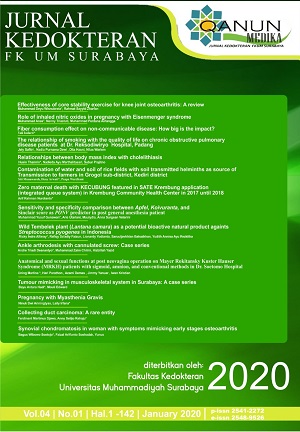Relationships Between Body Mass Index with Cholelithiasis
Abstract
Abstract
Gallstones formed due to imbalance of bile components, excessive/ high level of cholesterol, nor bilirubin. Obesity was a condition where body mass index (BMI) was excess, which can cause health problems such as an increase of cholesterol, triglycerides, insulin levels, and blood pressure. There’s growing attention to cholelithiasis in Indonesia, but there wasn’t any data on the prevalence due to the limited amount of study related to cholelithiasis and BMI. This study aimed to analyze the relationship between BMI and cholelithiasis in Dr. Soetomo General Hospital. An analytical descriptive study with the case-control design was conducted, and the data were collected from medical records. The sample was 124 patients from the internal outpatient clinic Dr. Soetomo General Hospital. The data were analyzed using a t-test 2 independent sample. The ratio between female and male patients was 3:1, mean of age was 36-45 years, 45.2% had weight range from 61-70 kg, 51.2% had height range 150-159 cm, the BMI from patient with cholelithiasis specifically 45.3% on at-risk scale and 40% on obese I, the result showed p-value 0.089 (p>0.05), which means that there was no significant differences with the BMI from patients with cholelithiasis and without cholelithiasis. In conclusion, BMI could not be used as a parameter to determine the occurrence of cholelithiasis on an individual.
Keywords: body mass index, cholelithiasis, gallstone
Full text article
References
Acalovschi, M. (2001). Cholesterol gallstones: from epidemiology to prevention. Medical Journal, 77(906), 221-229.
Bonfrate L, W. D., Garruti G, et al. (2014). Obesity and the risk and prognosis of gallstone disease and pancreatitis. Best Practice & Research Clinical Gastroenterology, 28(4), 633-635.
CDC. (2015). Body mass index (BMI) healthy weight. Retrieved from https: //www.cdc.gov/healthyweight/assessing/bmi/index.html .
DiMaria, G. R. (2006). Medical record versus researcher measures of height and weight. Biological Research For Nursing, 8(1), 15-23.
Engstrom JL, P. S., Doherty A et al. (2003). Accuracy of self-reported height and weight in women: An integrative review of the literature. Journal of Midwifery and Women's Health, 48(5), 338-345.
Maruyama N, L. T., Porto CS. (2013). Estrogen receptor ESR1 regulates the phospholipase C-inositol phosphate signaling in the hippocampus from rats in proestrous and estrous phases. Steroids, 78(1), 8-14.
Nihiser A, L. S., Wechsler H et al. (2007). Body mass index measurment in schools. Journal of School Health, 77(10), 51-671.
Panpimanmas S, M. C. (2009). Risk factors for gallstone disease in a Thai population. Journal of Epidemiology, 19(3), 116-121.
Sharma R, S. S., Sharma S. (2013). Preponderance of gallstone in female. World Journal of Pharmacy and Pharmaceutical Sciences.
Shrestha (2012). Relationship of lipid profile, BMI, and cholelithiasis in Nepalese population. Post Graduate Medical Journal of NAMS, 40-44.
WHO (2015). Global database on body mass index.
Authors

Qanun Medika by FK UM Surabaya is liscence under Lisensi Creative Commons Atribusi 4.0 Internasional.

